BTEC HND Business Unit 4: Management and Operations Report Analysis
VerifiedAdded on 2023/01/16
|17
|5480
|84
Report
AI Summary
This report, prepared for a BTEC HND Business course, delves into the core concepts of management and operations. It begins by differentiating between the roles and characteristics of leaders and managers, exploring their responsibilities within an organization, with Marks and Spencer used as a case study. The report then analyzes various leadership approaches, including situational, system, and contingency theories, evaluating their strengths and weaknesses and their applicability in different organizational scenarios. Furthermore, it examines different approaches to operational management, such as Lean Production and Six Sigma, highlighting their importance in achieving organizational objectives and the factors that influence business operations. The report critically evaluates the application of these management techniques and assesses their impact on business performance, concluding with an overview of the key findings and insights.
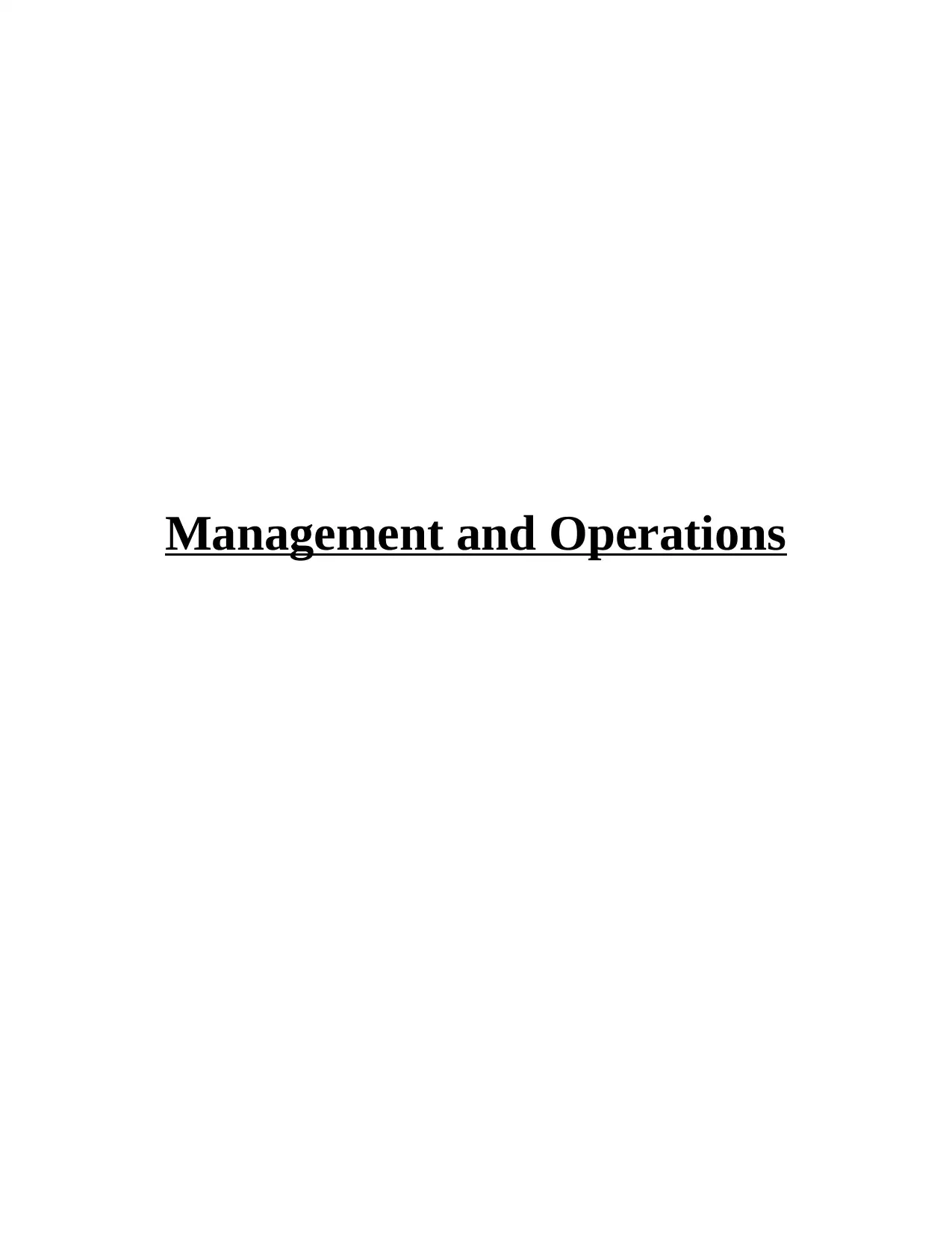
Management and Operations
Paraphrase This Document
Need a fresh take? Get an instant paraphrase of this document with our AI Paraphraser
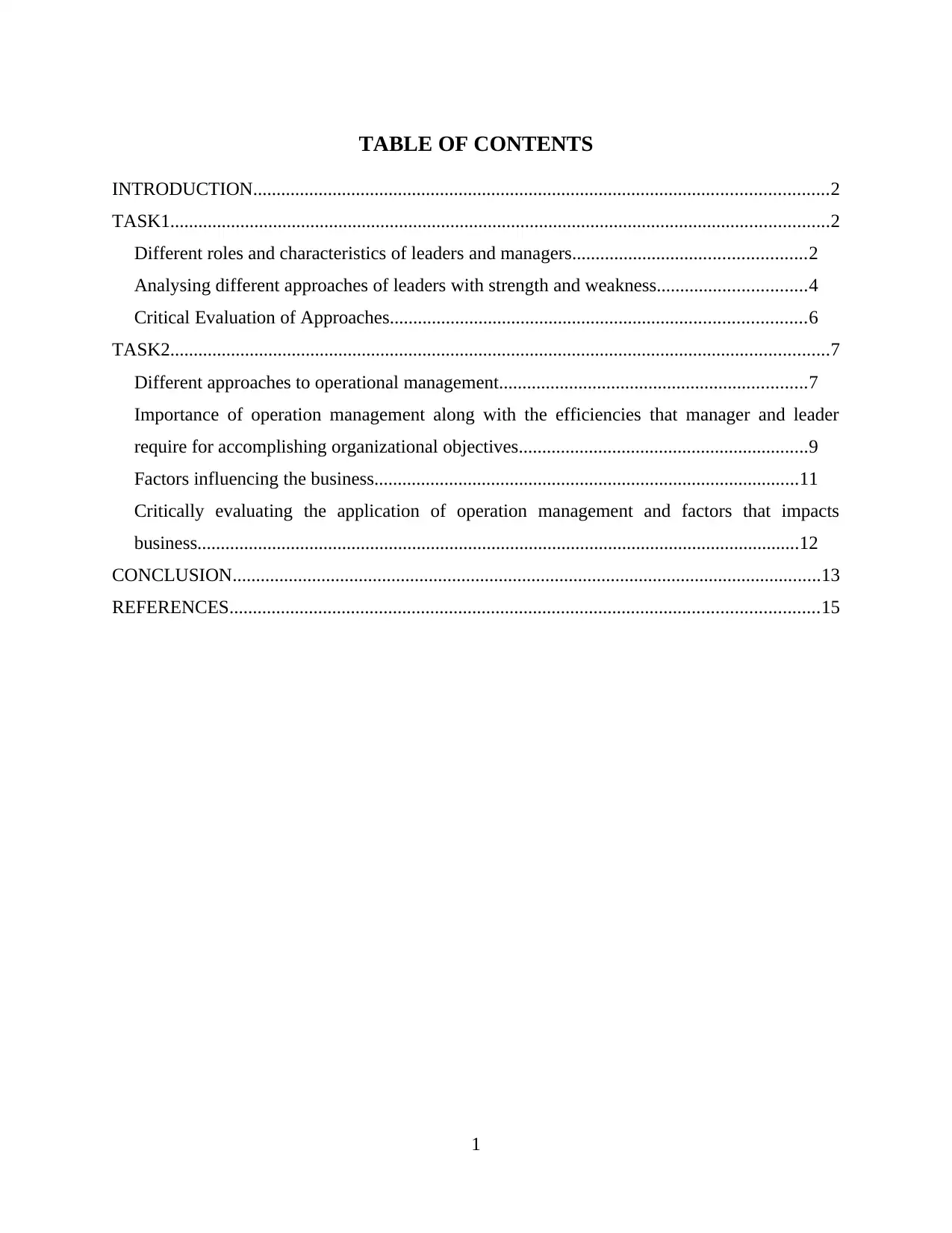
TABLE OF CONTENTS
INTRODUCTION...........................................................................................................................2
TASK1.............................................................................................................................................2
Different roles and characteristics of leaders and managers..................................................2
Analysing different approaches of leaders with strength and weakness................................4
Critical Evaluation of Approaches.........................................................................................6
TASK2.............................................................................................................................................7
Different approaches to operational management..................................................................7
Importance of operation management along with the efficiencies that manager and leader
require for accomplishing organizational objectives..............................................................9
Factors influencing the business...........................................................................................11
Critically evaluating the application of operation management and factors that impacts
business.................................................................................................................................12
CONCLUSION..............................................................................................................................13
REFERENCES..............................................................................................................................15
1
INTRODUCTION...........................................................................................................................2
TASK1.............................................................................................................................................2
Different roles and characteristics of leaders and managers..................................................2
Analysing different approaches of leaders with strength and weakness................................4
Critical Evaluation of Approaches.........................................................................................6
TASK2.............................................................................................................................................7
Different approaches to operational management..................................................................7
Importance of operation management along with the efficiencies that manager and leader
require for accomplishing organizational objectives..............................................................9
Factors influencing the business...........................................................................................11
Critically evaluating the application of operation management and factors that impacts
business.................................................................................................................................12
CONCLUSION..............................................................................................................................13
REFERENCES..............................................................................................................................15
1
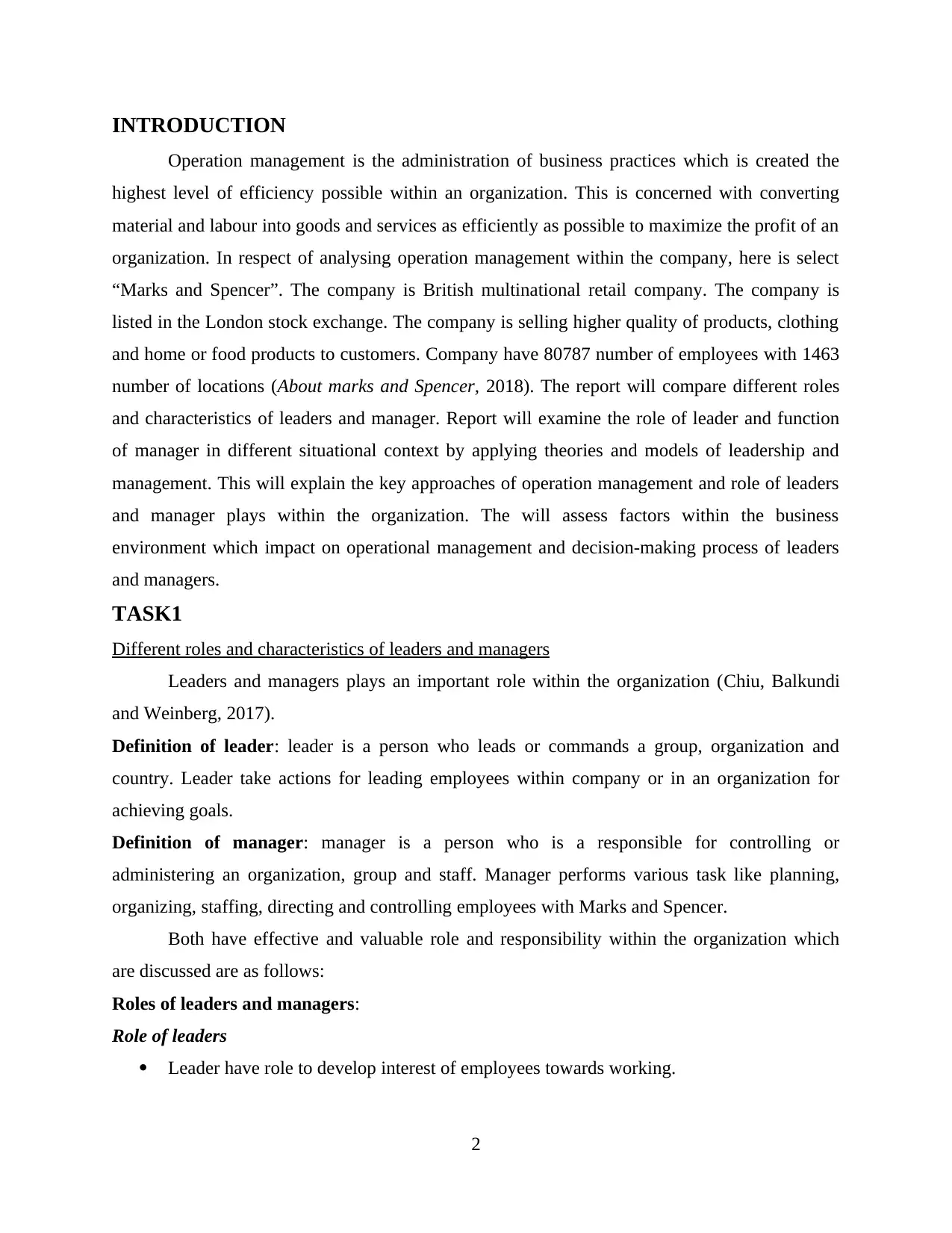
INTRODUCTION
Operation management is the administration of business practices which is created the
highest level of efficiency possible within an organization. This is concerned with converting
material and labour into goods and services as efficiently as possible to maximize the profit of an
organization. In respect of analysing operation management within the company, here is select
“Marks and Spencer”. The company is British multinational retail company. The company is
listed in the London stock exchange. The company is selling higher quality of products, clothing
and home or food products to customers. Company have 80787 number of employees with 1463
number of locations (About marks and Spencer, 2018). The report will compare different roles
and characteristics of leaders and manager. Report will examine the role of leader and function
of manager in different situational context by applying theories and models of leadership and
management. This will explain the key approaches of operation management and role of leaders
and manager plays within the organization. The will assess factors within the business
environment which impact on operational management and decision-making process of leaders
and managers.
TASK1
Different roles and characteristics of leaders and managers
Leaders and managers plays an important role within the organization (Chiu, Balkundi
and Weinberg, 2017).
Definition of leader: leader is a person who leads or commands a group, organization and
country. Leader take actions for leading employees within company or in an organization for
achieving goals.
Definition of manager: manager is a person who is a responsible for controlling or
administering an organization, group and staff. Manager performs various task like planning,
organizing, staffing, directing and controlling employees with Marks and Spencer.
Both have effective and valuable role and responsibility within the organization which
are discussed are as follows:
Roles of leaders and managers:
Role of leaders
Leader have role to develop interest of employees towards working.
2
Operation management is the administration of business practices which is created the
highest level of efficiency possible within an organization. This is concerned with converting
material and labour into goods and services as efficiently as possible to maximize the profit of an
organization. In respect of analysing operation management within the company, here is select
“Marks and Spencer”. The company is British multinational retail company. The company is
listed in the London stock exchange. The company is selling higher quality of products, clothing
and home or food products to customers. Company have 80787 number of employees with 1463
number of locations (About marks and Spencer, 2018). The report will compare different roles
and characteristics of leaders and manager. Report will examine the role of leader and function
of manager in different situational context by applying theories and models of leadership and
management. This will explain the key approaches of operation management and role of leaders
and manager plays within the organization. The will assess factors within the business
environment which impact on operational management and decision-making process of leaders
and managers.
TASK1
Different roles and characteristics of leaders and managers
Leaders and managers plays an important role within the organization (Chiu, Balkundi
and Weinberg, 2017).
Definition of leader: leader is a person who leads or commands a group, organization and
country. Leader take actions for leading employees within company or in an organization for
achieving goals.
Definition of manager: manager is a person who is a responsible for controlling or
administering an organization, group and staff. Manager performs various task like planning,
organizing, staffing, directing and controlling employees with Marks and Spencer.
Both have effective and valuable role and responsibility within the organization which
are discussed are as follows:
Roles of leaders and managers:
Role of leaders
Leader have role to develop interest of employees towards working.
2
⊘ This is a preview!⊘
Do you want full access?
Subscribe today to unlock all pages.

Trusted by 1+ million students worldwide
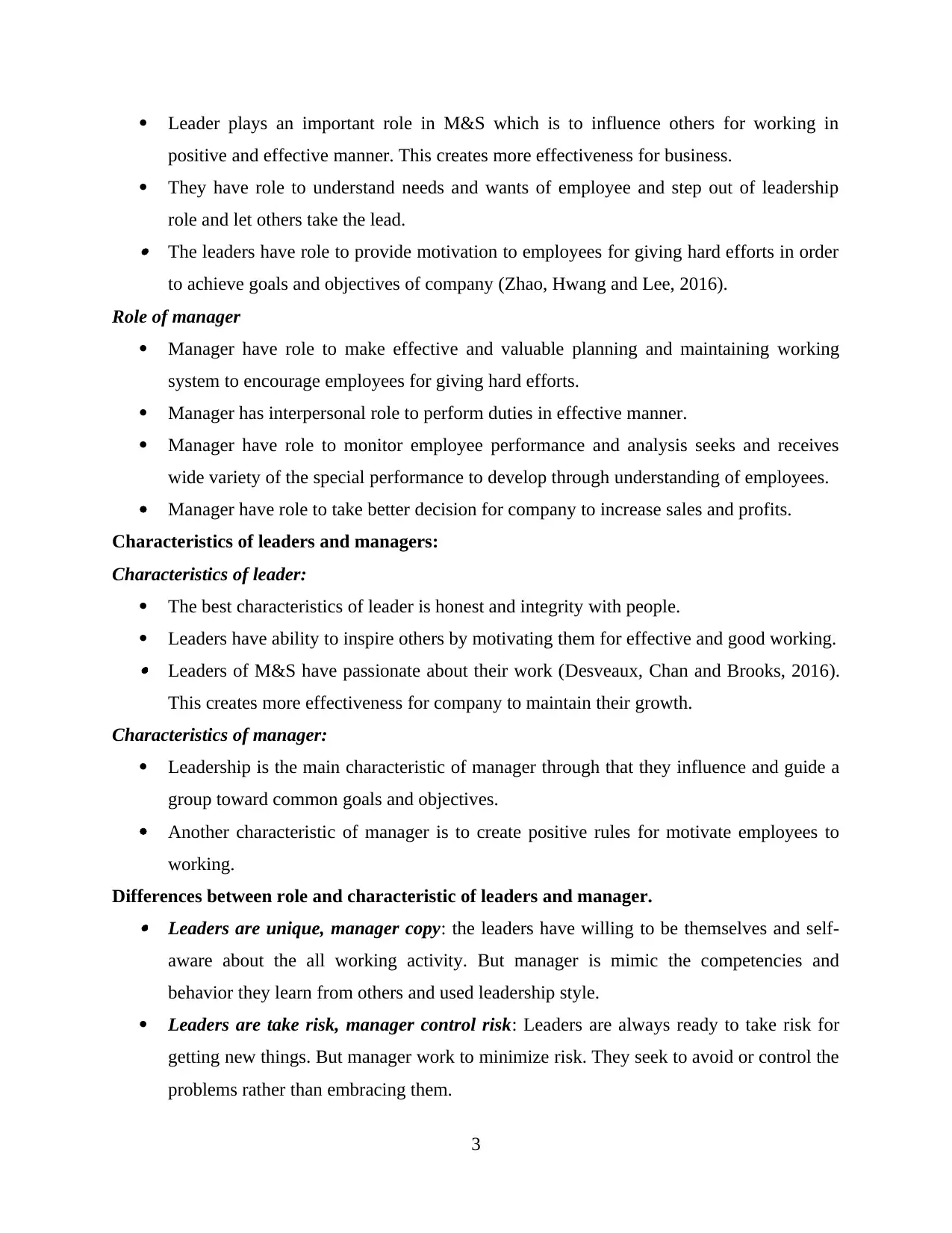
Leader plays an important role in M&S which is to influence others for working in
positive and effective manner. This creates more effectiveness for business.
They have role to understand needs and wants of employee and step out of leadership
role and let others take the lead. The leaders have role to provide motivation to employees for giving hard efforts in order
to achieve goals and objectives of company (Zhao, Hwang and Lee, 2016).
Role of manager
Manager have role to make effective and valuable planning and maintaining working
system to encourage employees for giving hard efforts.
Manager has interpersonal role to perform duties in effective manner.
Manager have role to monitor employee performance and analysis seeks and receives
wide variety of the special performance to develop through understanding of employees.
Manager have role to take better decision for company to increase sales and profits.
Characteristics of leaders and managers:
Characteristics of leader:
The best characteristics of leader is honest and integrity with people.
Leaders have ability to inspire others by motivating them for effective and good working. Leaders of M&S have passionate about their work (Desveaux, Chan and Brooks, 2016).
This creates more effectiveness for company to maintain their growth.
Characteristics of manager:
Leadership is the main characteristic of manager through that they influence and guide a
group toward common goals and objectives.
Another characteristic of manager is to create positive rules for motivate employees to
working.
Differences between role and characteristic of leaders and manager. Leaders are unique, manager copy: the leaders have willing to be themselves and self-
aware about the all working activity. But manager is mimic the competencies and
behavior they learn from others and used leadership style.
Leaders are take risk, manager control risk: Leaders are always ready to take risk for
getting new things. But manager work to minimize risk. They seek to avoid or control the
problems rather than embracing them.
3
positive and effective manner. This creates more effectiveness for business.
They have role to understand needs and wants of employee and step out of leadership
role and let others take the lead. The leaders have role to provide motivation to employees for giving hard efforts in order
to achieve goals and objectives of company (Zhao, Hwang and Lee, 2016).
Role of manager
Manager have role to make effective and valuable planning and maintaining working
system to encourage employees for giving hard efforts.
Manager has interpersonal role to perform duties in effective manner.
Manager have role to monitor employee performance and analysis seeks and receives
wide variety of the special performance to develop through understanding of employees.
Manager have role to take better decision for company to increase sales and profits.
Characteristics of leaders and managers:
Characteristics of leader:
The best characteristics of leader is honest and integrity with people.
Leaders have ability to inspire others by motivating them for effective and good working. Leaders of M&S have passionate about their work (Desveaux, Chan and Brooks, 2016).
This creates more effectiveness for company to maintain their growth.
Characteristics of manager:
Leadership is the main characteristic of manager through that they influence and guide a
group toward common goals and objectives.
Another characteristic of manager is to create positive rules for motivate employees to
working.
Differences between role and characteristic of leaders and manager. Leaders are unique, manager copy: the leaders have willing to be themselves and self-
aware about the all working activity. But manager is mimic the competencies and
behavior they learn from others and used leadership style.
Leaders are take risk, manager control risk: Leaders are always ready to take risk for
getting new things. But manager work to minimize risk. They seek to avoid or control the
problems rather than embracing them.
3
Paraphrase This Document
Need a fresh take? Get an instant paraphrase of this document with our AI Paraphraser
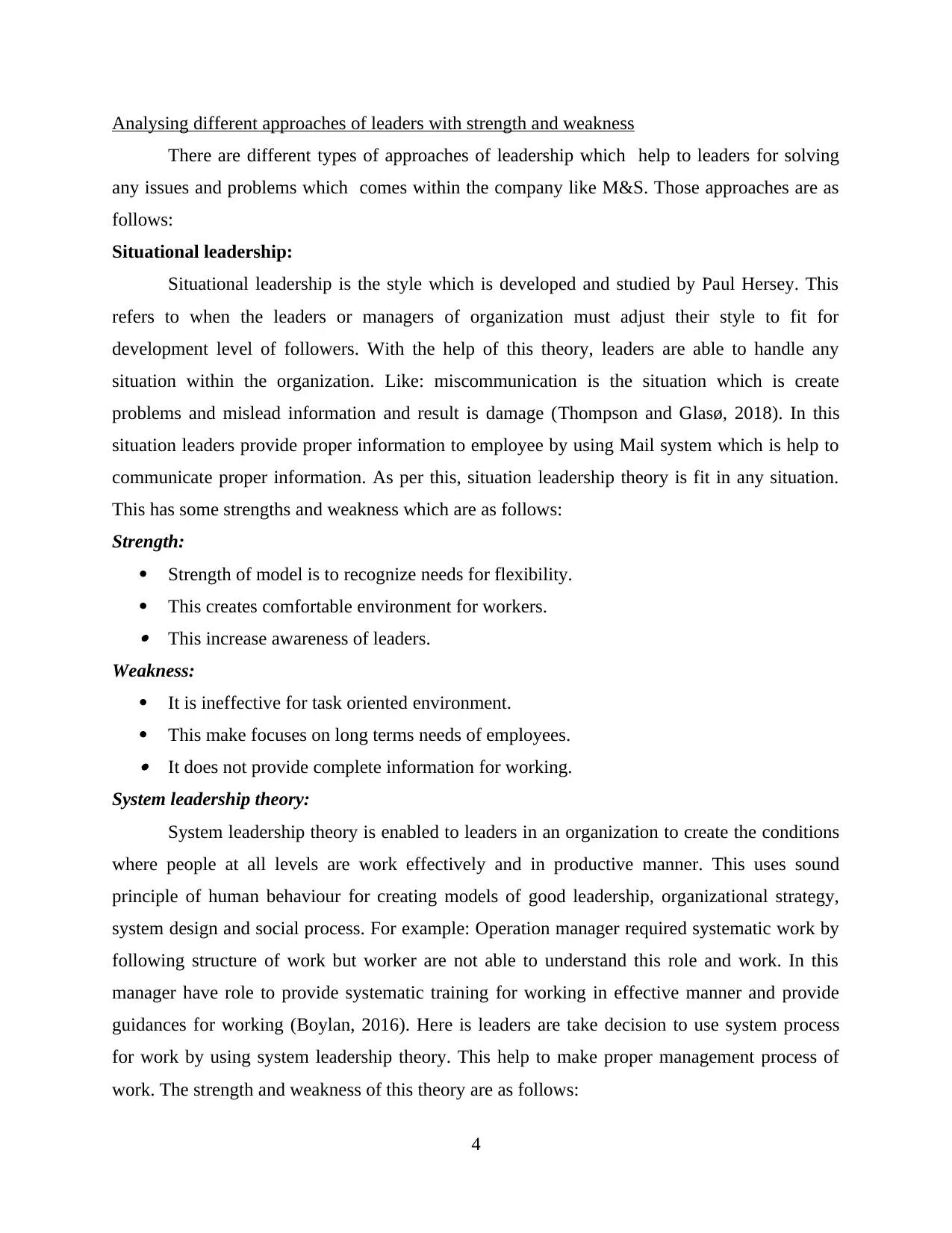
Analysing different approaches of leaders with strength and weakness
There are different types of approaches of leadership which help to leaders for solving
any issues and problems which comes within the company like M&S. Those approaches are as
follows:
Situational leadership:
Situational leadership is the style which is developed and studied by Paul Hersey. This
refers to when the leaders or managers of organization must adjust their style to fit for
development level of followers. With the help of this theory, leaders are able to handle any
situation within the organization. Like: miscommunication is the situation which is create
problems and mislead information and result is damage (Thompson and Glasø, 2018). In this
situation leaders provide proper information to employee by using Mail system which is help to
communicate proper information. As per this, situation leadership theory is fit in any situation.
This has some strengths and weakness which are as follows:
Strength:
Strength of model is to recognize needs for flexibility.
This creates comfortable environment for workers. This increase awareness of leaders.
Weakness:
It is ineffective for task oriented environment.
This make focuses on long terms needs of employees. It does not provide complete information for working.
System leadership theory:
System leadership theory is enabled to leaders in an organization to create the conditions
where people at all levels are work effectively and in productive manner. This uses sound
principle of human behaviour for creating models of good leadership, organizational strategy,
system design and social process. For example: Operation manager required systematic work by
following structure of work but worker are not able to understand this role and work. In this
manager have role to provide systematic training for working in effective manner and provide
guidances for working (Boylan, 2016). Here is leaders are take decision to use system process
for work by using system leadership theory. This help to make proper management process of
work. The strength and weakness of this theory are as follows:
4
There are different types of approaches of leadership which help to leaders for solving
any issues and problems which comes within the company like M&S. Those approaches are as
follows:
Situational leadership:
Situational leadership is the style which is developed and studied by Paul Hersey. This
refers to when the leaders or managers of organization must adjust their style to fit for
development level of followers. With the help of this theory, leaders are able to handle any
situation within the organization. Like: miscommunication is the situation which is create
problems and mislead information and result is damage (Thompson and Glasø, 2018). In this
situation leaders provide proper information to employee by using Mail system which is help to
communicate proper information. As per this, situation leadership theory is fit in any situation.
This has some strengths and weakness which are as follows:
Strength:
Strength of model is to recognize needs for flexibility.
This creates comfortable environment for workers. This increase awareness of leaders.
Weakness:
It is ineffective for task oriented environment.
This make focuses on long terms needs of employees. It does not provide complete information for working.
System leadership theory:
System leadership theory is enabled to leaders in an organization to create the conditions
where people at all levels are work effectively and in productive manner. This uses sound
principle of human behaviour for creating models of good leadership, organizational strategy,
system design and social process. For example: Operation manager required systematic work by
following structure of work but worker are not able to understand this role and work. In this
manager have role to provide systematic training for working in effective manner and provide
guidances for working (Boylan, 2016). Here is leaders are take decision to use system process
for work by using system leadership theory. This help to make proper management process of
work. The strength and weakness of this theory are as follows:
4
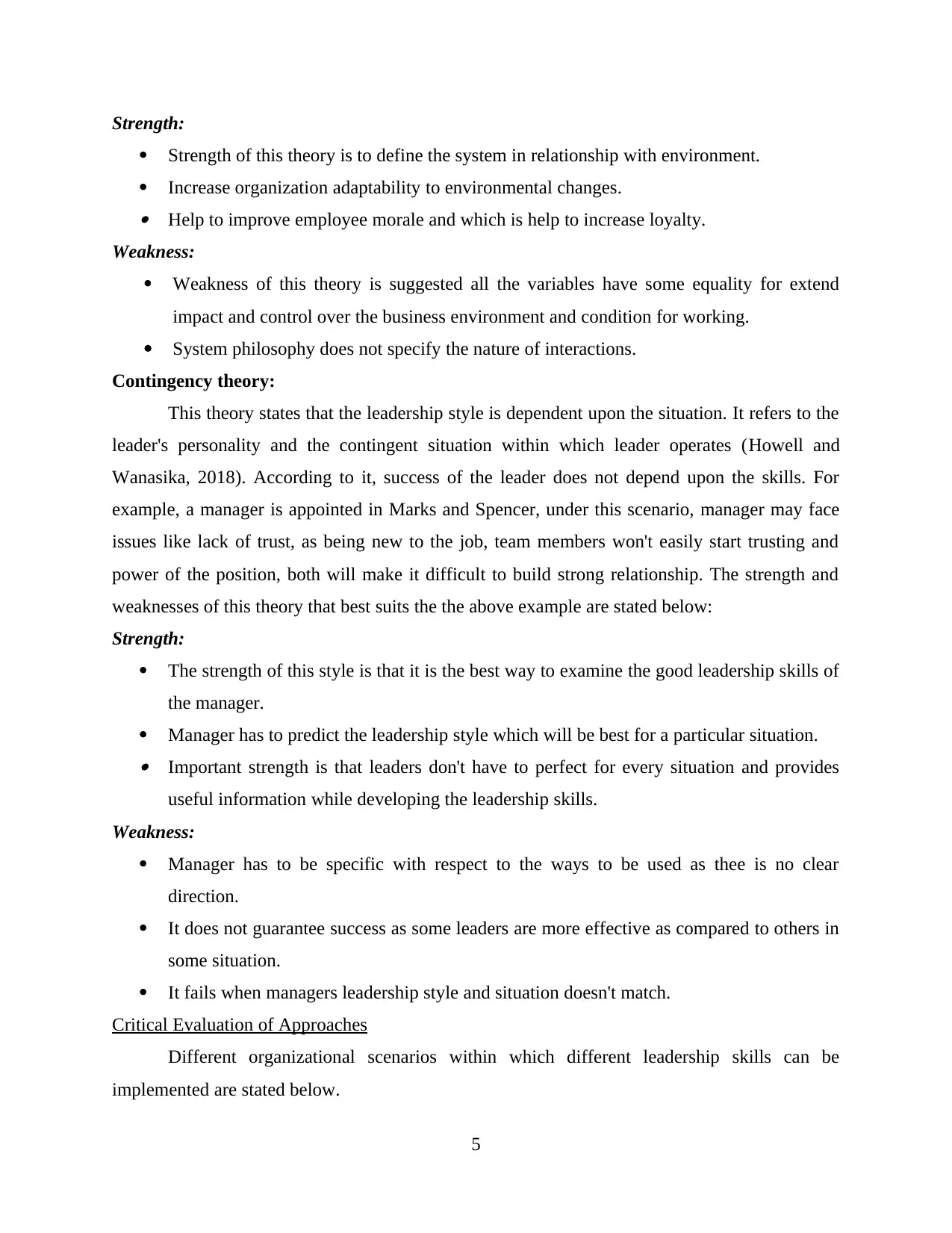
Strength:
Strength of this theory is to define the system in relationship with environment.
Increase organization adaptability to environmental changes. Help to improve employee morale and which is help to increase loyalty.
Weakness:
Weakness of this theory is suggested all the variables have some equality for extend
impact and control over the business environment and condition for working.
System philosophy does not specify the nature of interactions.
Contingency theory:
This theory states that the leadership style is dependent upon the situation. It refers to the
leader's personality and the contingent situation within which leader operates (Howell and
Wanasika, 2018). According to it, success of the leader does not depend upon the skills. For
example, a manager is appointed in Marks and Spencer, under this scenario, manager may face
issues like lack of trust, as being new to the job, team members won't easily start trusting and
power of the position, both will make it difficult to build strong relationship. The strength and
weaknesses of this theory that best suits the the above example are stated below:
Strength:
The strength of this style is that it is the best way to examine the good leadership skills of
the manager.
Manager has to predict the leadership style which will be best for a particular situation. Important strength is that leaders don't have to perfect for every situation and provides
useful information while developing the leadership skills.
Weakness:
Manager has to be specific with respect to the ways to be used as thee is no clear
direction.
It does not guarantee success as some leaders are more effective as compared to others in
some situation.
It fails when managers leadership style and situation doesn't match.
Critical Evaluation of Approaches
Different organizational scenarios within which different leadership skills can be
implemented are stated below.
5
Strength of this theory is to define the system in relationship with environment.
Increase organization adaptability to environmental changes. Help to improve employee morale and which is help to increase loyalty.
Weakness:
Weakness of this theory is suggested all the variables have some equality for extend
impact and control over the business environment and condition for working.
System philosophy does not specify the nature of interactions.
Contingency theory:
This theory states that the leadership style is dependent upon the situation. It refers to the
leader's personality and the contingent situation within which leader operates (Howell and
Wanasika, 2018). According to it, success of the leader does not depend upon the skills. For
example, a manager is appointed in Marks and Spencer, under this scenario, manager may face
issues like lack of trust, as being new to the job, team members won't easily start trusting and
power of the position, both will make it difficult to build strong relationship. The strength and
weaknesses of this theory that best suits the the above example are stated below:
Strength:
The strength of this style is that it is the best way to examine the good leadership skills of
the manager.
Manager has to predict the leadership style which will be best for a particular situation. Important strength is that leaders don't have to perfect for every situation and provides
useful information while developing the leadership skills.
Weakness:
Manager has to be specific with respect to the ways to be used as thee is no clear
direction.
It does not guarantee success as some leaders are more effective as compared to others in
some situation.
It fails when managers leadership style and situation doesn't match.
Critical Evaluation of Approaches
Different organizational scenarios within which different leadership skills can be
implemented are stated below.
5
⊘ This is a preview!⊘
Do you want full access?
Subscribe today to unlock all pages.

Trusted by 1+ million students worldwide
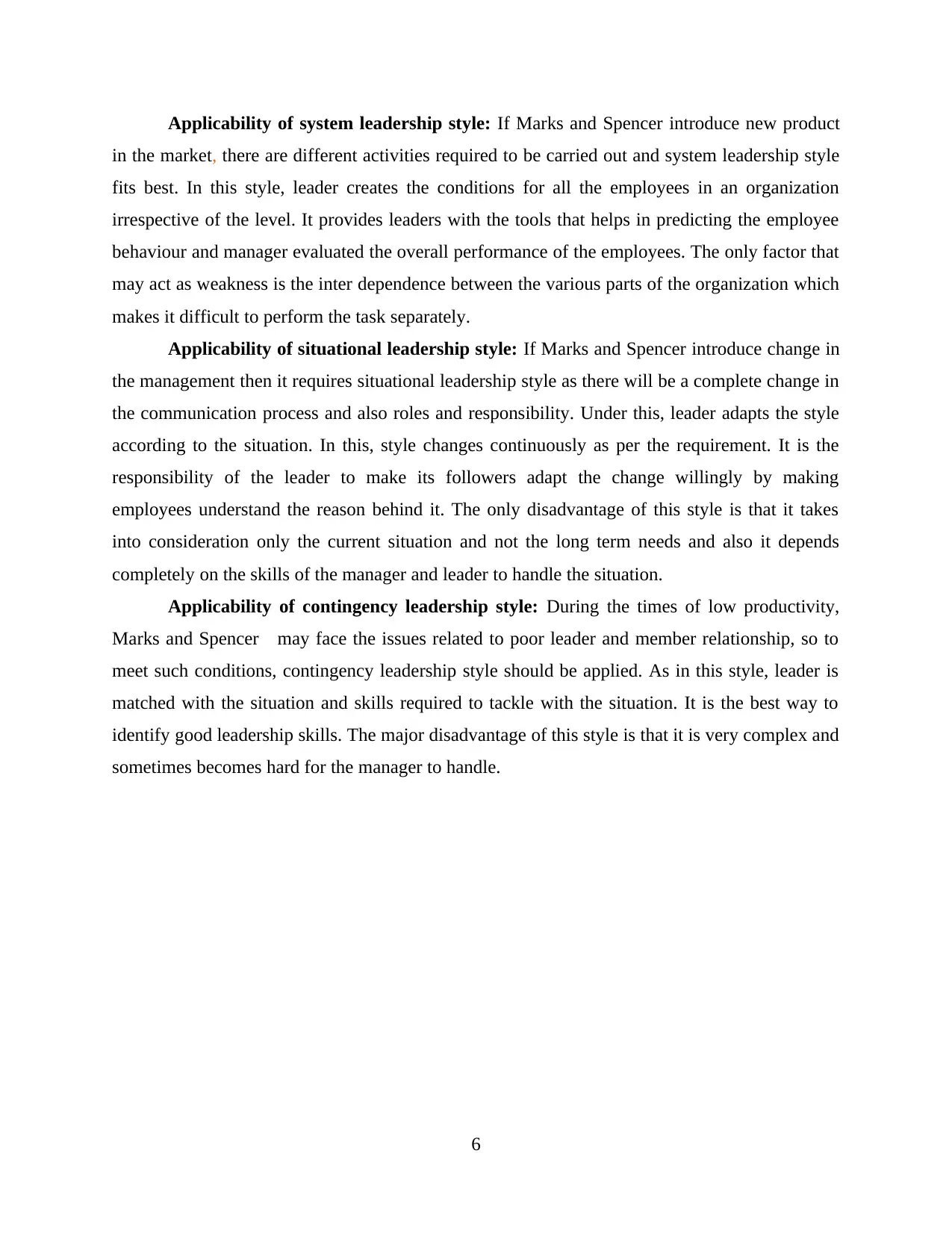
Applicability of system leadership style: If Marks and Spencer introduce new product
in the market, there are different activities required to be carried out and system leadership style
fits best. In this style, leader creates the conditions for all the employees in an organization
irrespective of the level. It provides leaders with the tools that helps in predicting the employee
behaviour and manager evaluated the overall performance of the employees. The only factor that
may act as weakness is the inter dependence between the various parts of the organization which
makes it difficult to perform the task separately.
Applicability of situational leadership style: If Marks and Spencer introduce change in
the management then it requires situational leadership style as there will be a complete change in
the communication process and also roles and responsibility. Under this, leader adapts the style
according to the situation. In this, style changes continuously as per the requirement. It is the
responsibility of the leader to make its followers adapt the change willingly by making
employees understand the reason behind it. The only disadvantage of this style is that it takes
into consideration only the current situation and not the long term needs and also it depends
completely on the skills of the manager and leader to handle the situation.
Applicability of contingency leadership style: During the times of low productivity,
Marks and Spencer may face the issues related to poor leader and member relationship, so to
meet such conditions, contingency leadership style should be applied. As in this style, leader is
matched with the situation and skills required to tackle with the situation. It is the best way to
identify good leadership skills. The major disadvantage of this style is that it is very complex and
sometimes becomes hard for the manager to handle.
6
in the market, there are different activities required to be carried out and system leadership style
fits best. In this style, leader creates the conditions for all the employees in an organization
irrespective of the level. It provides leaders with the tools that helps in predicting the employee
behaviour and manager evaluated the overall performance of the employees. The only factor that
may act as weakness is the inter dependence between the various parts of the organization which
makes it difficult to perform the task separately.
Applicability of situational leadership style: If Marks and Spencer introduce change in
the management then it requires situational leadership style as there will be a complete change in
the communication process and also roles and responsibility. Under this, leader adapts the style
according to the situation. In this, style changes continuously as per the requirement. It is the
responsibility of the leader to make its followers adapt the change willingly by making
employees understand the reason behind it. The only disadvantage of this style is that it takes
into consideration only the current situation and not the long term needs and also it depends
completely on the skills of the manager and leader to handle the situation.
Applicability of contingency leadership style: During the times of low productivity,
Marks and Spencer may face the issues related to poor leader and member relationship, so to
meet such conditions, contingency leadership style should be applied. As in this style, leader is
matched with the situation and skills required to tackle with the situation. It is the best way to
identify good leadership skills. The major disadvantage of this style is that it is very complex and
sometimes becomes hard for the manager to handle.
6
Paraphrase This Document
Need a fresh take? Get an instant paraphrase of this document with our AI Paraphraser
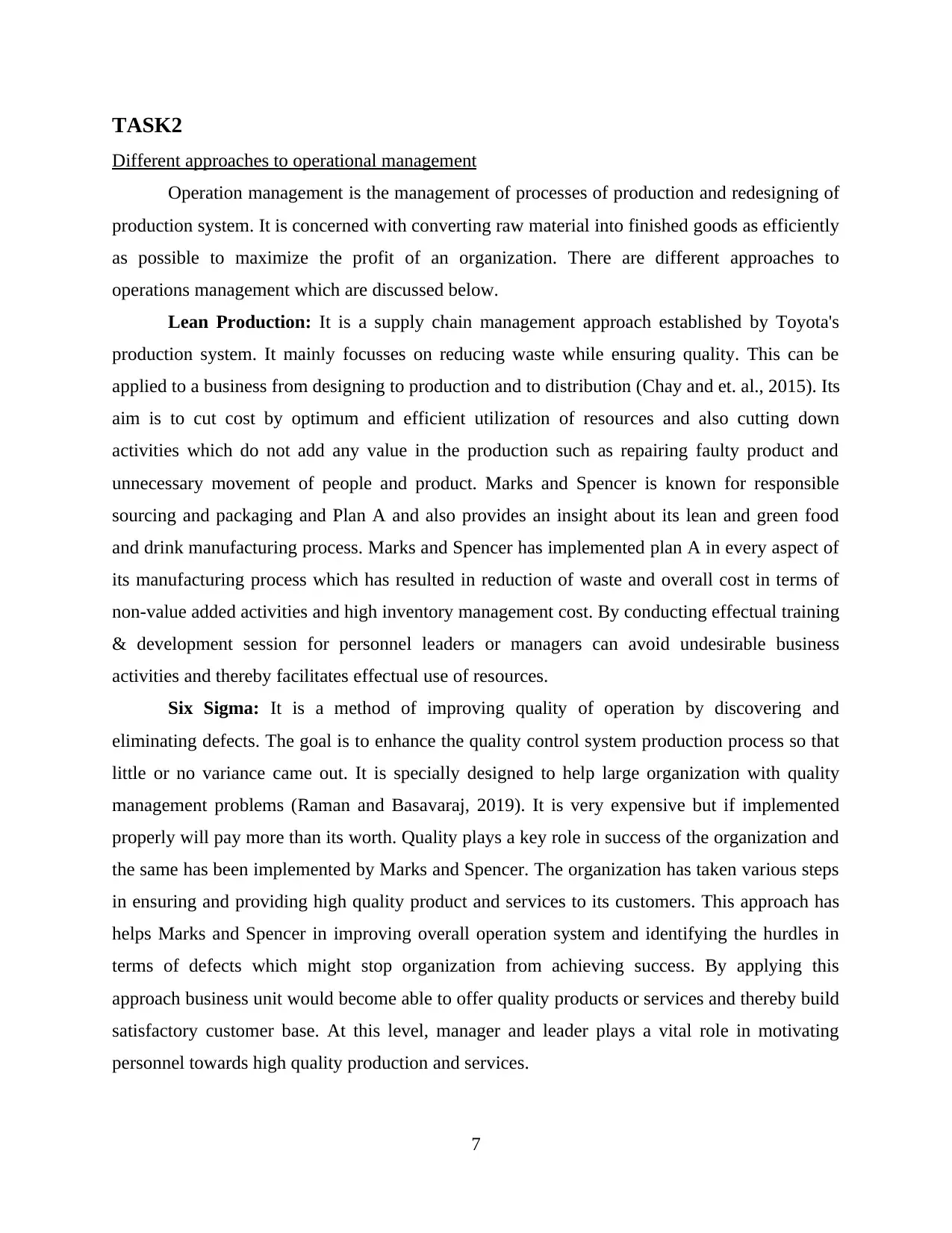
TASK2
Different approaches to operational management
Operation management is the management of processes of production and redesigning of
production system. It is concerned with converting raw material into finished goods as efficiently
as possible to maximize the profit of an organization. There are different approaches to
operations management which are discussed below.
Lean Production: It is a supply chain management approach established by Toyota's
production system. It mainly focusses on reducing waste while ensuring quality. This can be
applied to a business from designing to production and to distribution (Chay and et. al., 2015). Its
aim is to cut cost by optimum and efficient utilization of resources and also cutting down
activities which do not add any value in the production such as repairing faulty product and
unnecessary movement of people and product. Marks and Spencer is known for responsible
sourcing and packaging and Plan A and also provides an insight about its lean and green food
and drink manufacturing process. Marks and Spencer has implemented plan A in every aspect of
its manufacturing process which has resulted in reduction of waste and overall cost in terms of
non-value added activities and high inventory management cost. By conducting effectual training
& development session for personnel leaders or managers can avoid undesirable business
activities and thereby facilitates effectual use of resources.
Six Sigma: It is a method of improving quality of operation by discovering and
eliminating defects. The goal is to enhance the quality control system production process so that
little or no variance came out. It is specially designed to help large organization with quality
management problems (Raman and Basavaraj, 2019). It is very expensive but if implemented
properly will pay more than its worth. Quality plays a key role in success of the organization and
the same has been implemented by Marks and Spencer. The organization has taken various steps
in ensuring and providing high quality product and services to its customers. This approach has
helps Marks and Spencer in improving overall operation system and identifying the hurdles in
terms of defects which might stop organization from achieving success. By applying this
approach business unit would become able to offer quality products or services and thereby build
satisfactory customer base. At this level, manager and leader plays a vital role in motivating
personnel towards high quality production and services.
7
Different approaches to operational management
Operation management is the management of processes of production and redesigning of
production system. It is concerned with converting raw material into finished goods as efficiently
as possible to maximize the profit of an organization. There are different approaches to
operations management which are discussed below.
Lean Production: It is a supply chain management approach established by Toyota's
production system. It mainly focusses on reducing waste while ensuring quality. This can be
applied to a business from designing to production and to distribution (Chay and et. al., 2015). Its
aim is to cut cost by optimum and efficient utilization of resources and also cutting down
activities which do not add any value in the production such as repairing faulty product and
unnecessary movement of people and product. Marks and Spencer is known for responsible
sourcing and packaging and Plan A and also provides an insight about its lean and green food
and drink manufacturing process. Marks and Spencer has implemented plan A in every aspect of
its manufacturing process which has resulted in reduction of waste and overall cost in terms of
non-value added activities and high inventory management cost. By conducting effectual training
& development session for personnel leaders or managers can avoid undesirable business
activities and thereby facilitates effectual use of resources.
Six Sigma: It is a method of improving quality of operation by discovering and
eliminating defects. The goal is to enhance the quality control system production process so that
little or no variance came out. It is specially designed to help large organization with quality
management problems (Raman and Basavaraj, 2019). It is very expensive but if implemented
properly will pay more than its worth. Quality plays a key role in success of the organization and
the same has been implemented by Marks and Spencer. The organization has taken various steps
in ensuring and providing high quality product and services to its customers. This approach has
helps Marks and Spencer in improving overall operation system and identifying the hurdles in
terms of defects which might stop organization from achieving success. By applying this
approach business unit would become able to offer quality products or services and thereby build
satisfactory customer base. At this level, manager and leader plays a vital role in motivating
personnel towards high quality production and services.
7
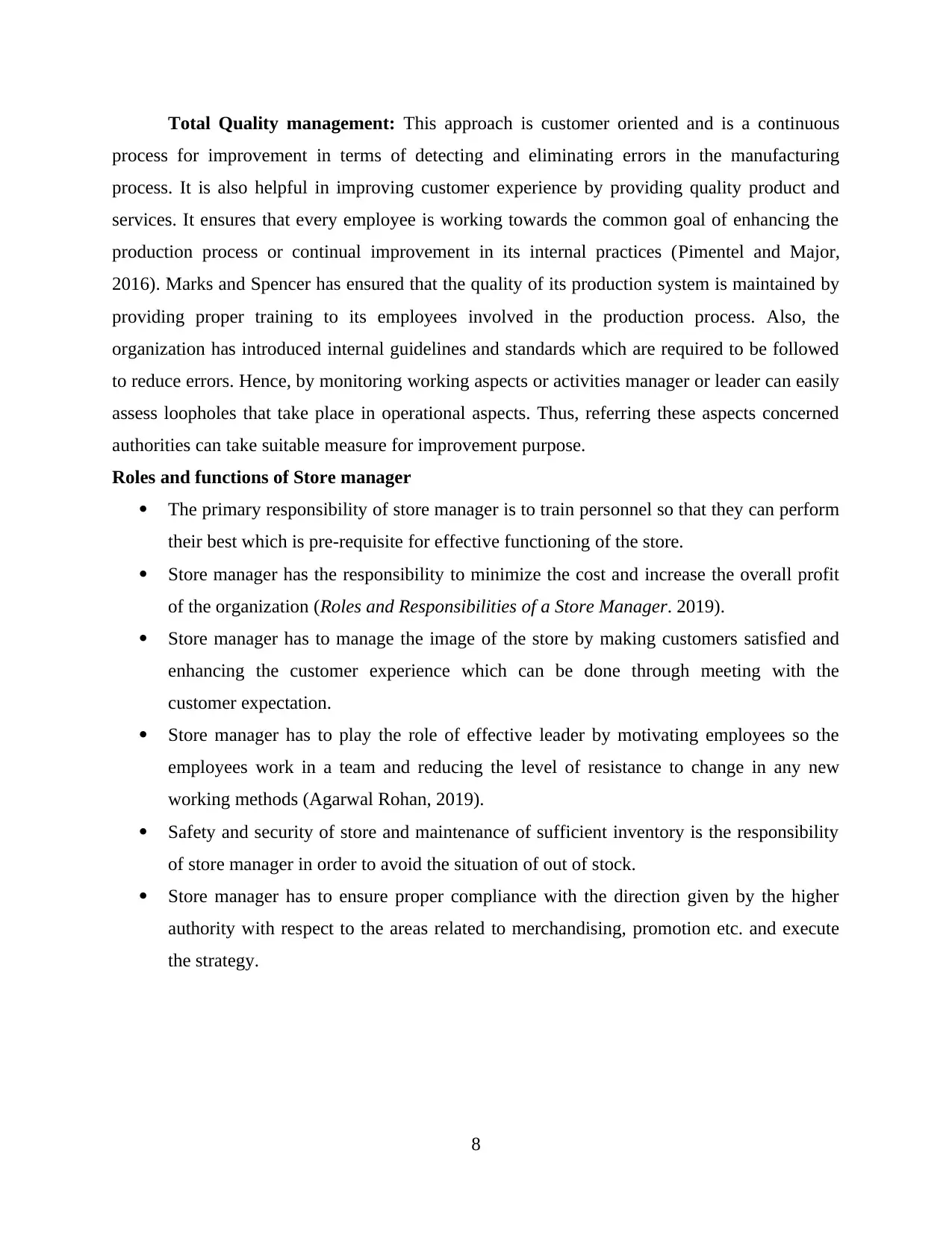
Total Quality management: This approach is customer oriented and is a continuous
process for improvement in terms of detecting and eliminating errors in the manufacturing
process. It is also helpful in improving customer experience by providing quality product and
services. It ensures that every employee is working towards the common goal of enhancing the
production process or continual improvement in its internal practices (Pimentel and Major,
2016). Marks and Spencer has ensured that the quality of its production system is maintained by
providing proper training to its employees involved in the production process. Also, the
organization has introduced internal guidelines and standards which are required to be followed
to reduce errors. Hence, by monitoring working aspects or activities manager or leader can easily
assess loopholes that take place in operational aspects. Thus, referring these aspects concerned
authorities can take suitable measure for improvement purpose.
Roles and functions of Store manager
The primary responsibility of store manager is to train personnel so that they can perform
their best which is pre-requisite for effective functioning of the store.
Store manager has the responsibility to minimize the cost and increase the overall profit
of the organization (Roles and Responsibilities of a Store Manager. 2019).
Store manager has to manage the image of the store by making customers satisfied and
enhancing the customer experience which can be done through meeting with the
customer expectation.
Store manager has to play the role of effective leader by motivating employees so the
employees work in a team and reducing the level of resistance to change in any new
working methods (Agarwal Rohan, 2019).
Safety and security of store and maintenance of sufficient inventory is the responsibility
of store manager in order to avoid the situation of out of stock.
Store manager has to ensure proper compliance with the direction given by the higher
authority with respect to the areas related to merchandising, promotion etc. and execute
the strategy.
8
process for improvement in terms of detecting and eliminating errors in the manufacturing
process. It is also helpful in improving customer experience by providing quality product and
services. It ensures that every employee is working towards the common goal of enhancing the
production process or continual improvement in its internal practices (Pimentel and Major,
2016). Marks and Spencer has ensured that the quality of its production system is maintained by
providing proper training to its employees involved in the production process. Also, the
organization has introduced internal guidelines and standards which are required to be followed
to reduce errors. Hence, by monitoring working aspects or activities manager or leader can easily
assess loopholes that take place in operational aspects. Thus, referring these aspects concerned
authorities can take suitable measure for improvement purpose.
Roles and functions of Store manager
The primary responsibility of store manager is to train personnel so that they can perform
their best which is pre-requisite for effective functioning of the store.
Store manager has the responsibility to minimize the cost and increase the overall profit
of the organization (Roles and Responsibilities of a Store Manager. 2019).
Store manager has to manage the image of the store by making customers satisfied and
enhancing the customer experience which can be done through meeting with the
customer expectation.
Store manager has to play the role of effective leader by motivating employees so the
employees work in a team and reducing the level of resistance to change in any new
working methods (Agarwal Rohan, 2019).
Safety and security of store and maintenance of sufficient inventory is the responsibility
of store manager in order to avoid the situation of out of stock.
Store manager has to ensure proper compliance with the direction given by the higher
authority with respect to the areas related to merchandising, promotion etc. and execute
the strategy.
8
⊘ This is a preview!⊘
Do you want full access?
Subscribe today to unlock all pages.

Trusted by 1+ million students worldwide
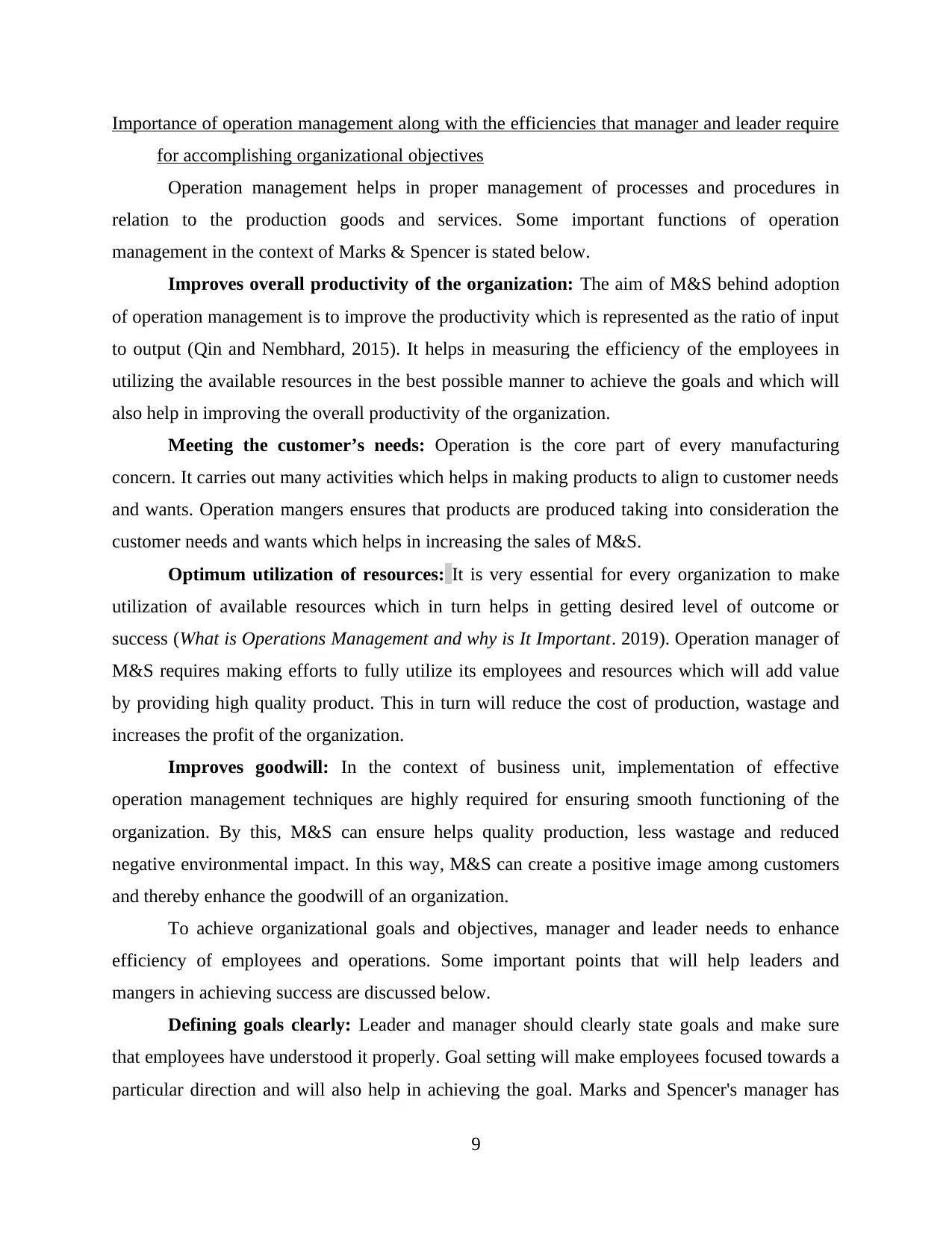
Importance of operation management along with the efficiencies that manager and leader require
for accomplishing organizational objectives
Operation management helps in proper management of processes and procedures in
relation to the production goods and services. Some important functions of operation
management in the context of Marks & Spencer is stated below.
Improves overall productivity of the organization: The aim of M&S behind adoption
of operation management is to improve the productivity which is represented as the ratio of input
to output (Qin and Nembhard, 2015). It helps in measuring the efficiency of the employees in
utilizing the available resources in the best possible manner to achieve the goals and which will
also help in improving the overall productivity of the organization.
Meeting the customer’s needs: Operation is the core part of every manufacturing
concern. It carries out many activities which helps in making products to align to customer needs
and wants. Operation mangers ensures that products are produced taking into consideration the
customer needs and wants which helps in increasing the sales of M&S.
Optimum utilization of resources: It is very essential for every organization to make
utilization of available resources which in turn helps in getting desired level of outcome or
success (What is Operations Management and why is It Important. 2019). Operation manager of
M&S requires making efforts to fully utilize its employees and resources which will add value
by providing high quality product. This in turn will reduce the cost of production, wastage and
increases the profit of the organization.
Improves goodwill: In the context of business unit, implementation of effective
operation management techniques are highly required for ensuring smooth functioning of the
organization. By this, M&S can ensure helps quality production, less wastage and reduced
negative environmental impact. In this way, M&S can create a positive image among customers
and thereby enhance the goodwill of an organization.
To achieve organizational goals and objectives, manager and leader needs to enhance
efficiency of employees and operations. Some important points that will help leaders and
mangers in achieving success are discussed below.
Defining goals clearly: Leader and manager should clearly state goals and make sure
that employees have understood it properly. Goal setting will make employees focused towards a
particular direction and will also help in achieving the goal. Marks and Spencer's manager has
9
for accomplishing organizational objectives
Operation management helps in proper management of processes and procedures in
relation to the production goods and services. Some important functions of operation
management in the context of Marks & Spencer is stated below.
Improves overall productivity of the organization: The aim of M&S behind adoption
of operation management is to improve the productivity which is represented as the ratio of input
to output (Qin and Nembhard, 2015). It helps in measuring the efficiency of the employees in
utilizing the available resources in the best possible manner to achieve the goals and which will
also help in improving the overall productivity of the organization.
Meeting the customer’s needs: Operation is the core part of every manufacturing
concern. It carries out many activities which helps in making products to align to customer needs
and wants. Operation mangers ensures that products are produced taking into consideration the
customer needs and wants which helps in increasing the sales of M&S.
Optimum utilization of resources: It is very essential for every organization to make
utilization of available resources which in turn helps in getting desired level of outcome or
success (What is Operations Management and why is It Important. 2019). Operation manager of
M&S requires making efforts to fully utilize its employees and resources which will add value
by providing high quality product. This in turn will reduce the cost of production, wastage and
increases the profit of the organization.
Improves goodwill: In the context of business unit, implementation of effective
operation management techniques are highly required for ensuring smooth functioning of the
organization. By this, M&S can ensure helps quality production, less wastage and reduced
negative environmental impact. In this way, M&S can create a positive image among customers
and thereby enhance the goodwill of an organization.
To achieve organizational goals and objectives, manager and leader needs to enhance
efficiency of employees and operations. Some important points that will help leaders and
mangers in achieving success are discussed below.
Defining goals clearly: Leader and manager should clearly state goals and make sure
that employees have understood it properly. Goal setting will make employees focused towards a
particular direction and will also help in achieving the goal. Marks and Spencer's manager has
9
Paraphrase This Document
Need a fresh take? Get an instant paraphrase of this document with our AI Paraphraser
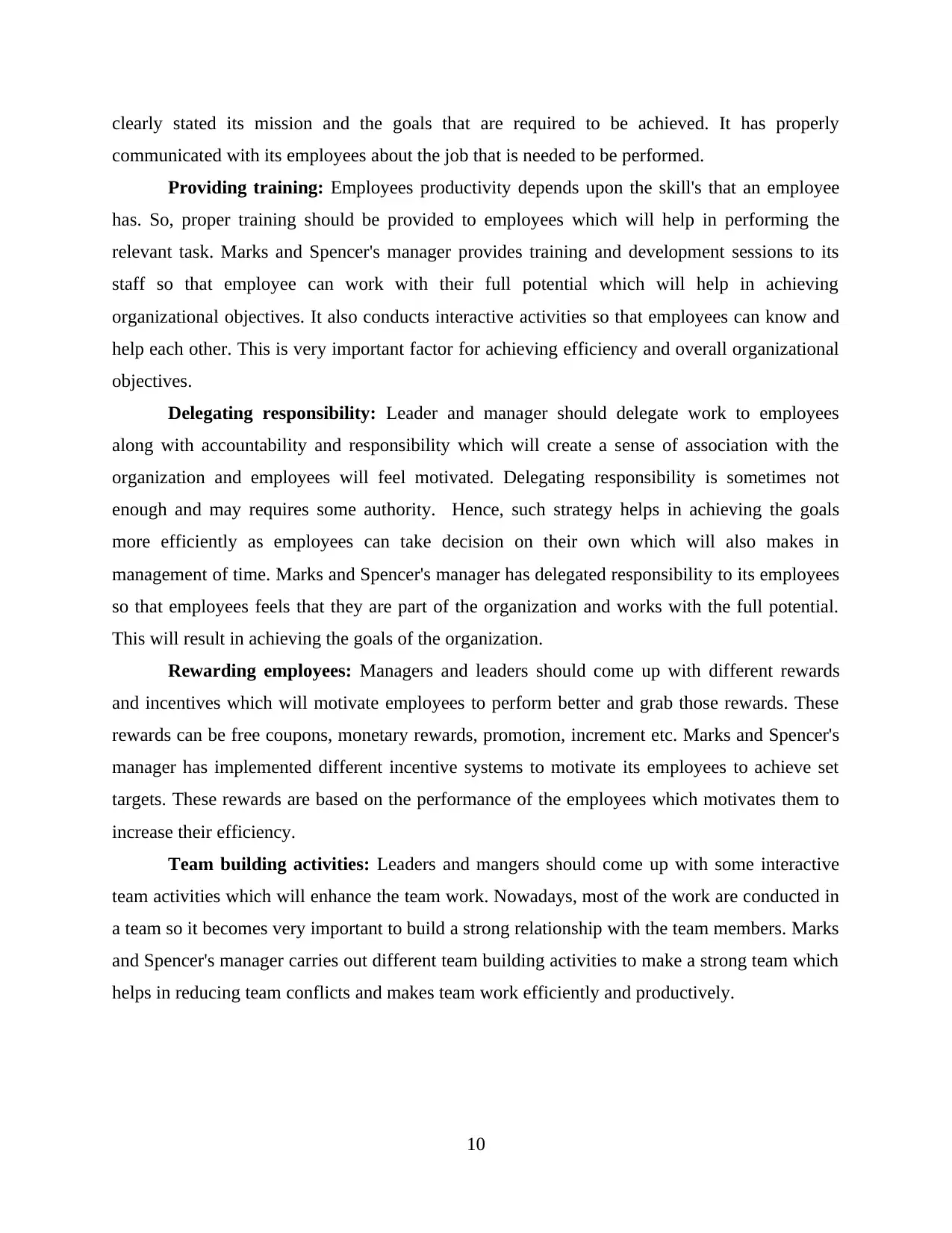
clearly stated its mission and the goals that are required to be achieved. It has properly
communicated with its employees about the job that is needed to be performed.
Providing training: Employees productivity depends upon the skill's that an employee
has. So, proper training should be provided to employees which will help in performing the
relevant task. Marks and Spencer's manager provides training and development sessions to its
staff so that employee can work with their full potential which will help in achieving
organizational objectives. It also conducts interactive activities so that employees can know and
help each other. This is very important factor for achieving efficiency and overall organizational
objectives.
Delegating responsibility: Leader and manager should delegate work to employees
along with accountability and responsibility which will create a sense of association with the
organization and employees will feel motivated. Delegating responsibility is sometimes not
enough and may requires some authority. Hence, such strategy helps in achieving the goals
more efficiently as employees can take decision on their own which will also makes in
management of time. Marks and Spencer's manager has delegated responsibility to its employees
so that employees feels that they are part of the organization and works with the full potential.
This will result in achieving the goals of the organization.
Rewarding employees: Managers and leaders should come up with different rewards
and incentives which will motivate employees to perform better and grab those rewards. These
rewards can be free coupons, monetary rewards, promotion, increment etc. Marks and Spencer's
manager has implemented different incentive systems to motivate its employees to achieve set
targets. These rewards are based on the performance of the employees which motivates them to
increase their efficiency.
Team building activities: Leaders and mangers should come up with some interactive
team activities which will enhance the team work. Nowadays, most of the work are conducted in
a team so it becomes very important to build a strong relationship with the team members. Marks
and Spencer's manager carries out different team building activities to make a strong team which
helps in reducing team conflicts and makes team work efficiently and productively.
10
communicated with its employees about the job that is needed to be performed.
Providing training: Employees productivity depends upon the skill's that an employee
has. So, proper training should be provided to employees which will help in performing the
relevant task. Marks and Spencer's manager provides training and development sessions to its
staff so that employee can work with their full potential which will help in achieving
organizational objectives. It also conducts interactive activities so that employees can know and
help each other. This is very important factor for achieving efficiency and overall organizational
objectives.
Delegating responsibility: Leader and manager should delegate work to employees
along with accountability and responsibility which will create a sense of association with the
organization and employees will feel motivated. Delegating responsibility is sometimes not
enough and may requires some authority. Hence, such strategy helps in achieving the goals
more efficiently as employees can take decision on their own which will also makes in
management of time. Marks and Spencer's manager has delegated responsibility to its employees
so that employees feels that they are part of the organization and works with the full potential.
This will result in achieving the goals of the organization.
Rewarding employees: Managers and leaders should come up with different rewards
and incentives which will motivate employees to perform better and grab those rewards. These
rewards can be free coupons, monetary rewards, promotion, increment etc. Marks and Spencer's
manager has implemented different incentive systems to motivate its employees to achieve set
targets. These rewards are based on the performance of the employees which motivates them to
increase their efficiency.
Team building activities: Leaders and mangers should come up with some interactive
team activities which will enhance the team work. Nowadays, most of the work are conducted in
a team so it becomes very important to build a strong relationship with the team members. Marks
and Spencer's manager carries out different team building activities to make a strong team which
helps in reducing team conflicts and makes team work efficiently and productively.
10
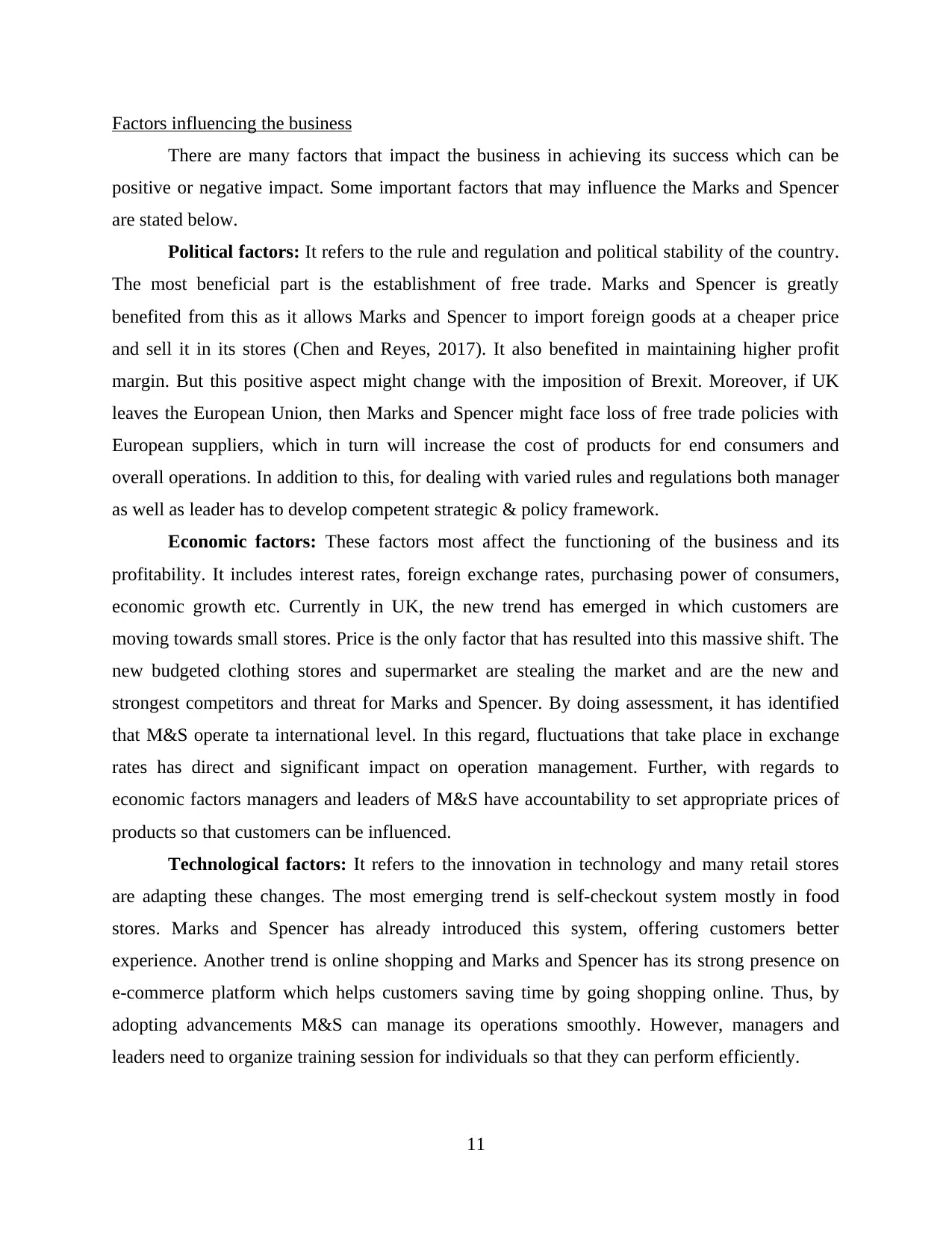
Factors influencing the business
There are many factors that impact the business in achieving its success which can be
positive or negative impact. Some important factors that may influence the Marks and Spencer
are stated below.
Political factors: It refers to the rule and regulation and political stability of the country.
The most beneficial part is the establishment of free trade. Marks and Spencer is greatly
benefited from this as it allows Marks and Spencer to import foreign goods at a cheaper price
and sell it in its stores (Chen and Reyes, 2017). It also benefited in maintaining higher profit
margin. But this positive aspect might change with the imposition of Brexit. Moreover, if UK
leaves the European Union, then Marks and Spencer might face loss of free trade policies with
European suppliers, which in turn will increase the cost of products for end consumers and
overall operations. In addition to this, for dealing with varied rules and regulations both manager
as well as leader has to develop competent strategic & policy framework.
Economic factors: These factors most affect the functioning of the business and its
profitability. It includes interest rates, foreign exchange rates, purchasing power of consumers,
economic growth etc. Currently in UK, the new trend has emerged in which customers are
moving towards small stores. Price is the only factor that has resulted into this massive shift. The
new budgeted clothing stores and supermarket are stealing the market and are the new and
strongest competitors and threat for Marks and Spencer. By doing assessment, it has identified
that M&S operate ta international level. In this regard, fluctuations that take place in exchange
rates has direct and significant impact on operation management. Further, with regards to
economic factors managers and leaders of M&S have accountability to set appropriate prices of
products so that customers can be influenced.
Technological factors: It refers to the innovation in technology and many retail stores
are adapting these changes. The most emerging trend is self-checkout system mostly in food
stores. Marks and Spencer has already introduced this system, offering customers better
experience. Another trend is online shopping and Marks and Spencer has its strong presence on
e-commerce platform which helps customers saving time by going shopping online. Thus, by
adopting advancements M&S can manage its operations smoothly. However, managers and
leaders need to organize training session for individuals so that they can perform efficiently.
11
There are many factors that impact the business in achieving its success which can be
positive or negative impact. Some important factors that may influence the Marks and Spencer
are stated below.
Political factors: It refers to the rule and regulation and political stability of the country.
The most beneficial part is the establishment of free trade. Marks and Spencer is greatly
benefited from this as it allows Marks and Spencer to import foreign goods at a cheaper price
and sell it in its stores (Chen and Reyes, 2017). It also benefited in maintaining higher profit
margin. But this positive aspect might change with the imposition of Brexit. Moreover, if UK
leaves the European Union, then Marks and Spencer might face loss of free trade policies with
European suppliers, which in turn will increase the cost of products for end consumers and
overall operations. In addition to this, for dealing with varied rules and regulations both manager
as well as leader has to develop competent strategic & policy framework.
Economic factors: These factors most affect the functioning of the business and its
profitability. It includes interest rates, foreign exchange rates, purchasing power of consumers,
economic growth etc. Currently in UK, the new trend has emerged in which customers are
moving towards small stores. Price is the only factor that has resulted into this massive shift. The
new budgeted clothing stores and supermarket are stealing the market and are the new and
strongest competitors and threat for Marks and Spencer. By doing assessment, it has identified
that M&S operate ta international level. In this regard, fluctuations that take place in exchange
rates has direct and significant impact on operation management. Further, with regards to
economic factors managers and leaders of M&S have accountability to set appropriate prices of
products so that customers can be influenced.
Technological factors: It refers to the innovation in technology and many retail stores
are adapting these changes. The most emerging trend is self-checkout system mostly in food
stores. Marks and Spencer has already introduced this system, offering customers better
experience. Another trend is online shopping and Marks and Spencer has its strong presence on
e-commerce platform which helps customers saving time by going shopping online. Thus, by
adopting advancements M&S can manage its operations smoothly. However, managers and
leaders need to organize training session for individuals so that they can perform efficiently.
11
⊘ This is a preview!⊘
Do you want full access?
Subscribe today to unlock all pages.

Trusted by 1+ million students worldwide
1 out of 17
Related Documents
Your All-in-One AI-Powered Toolkit for Academic Success.
+13062052269
info@desklib.com
Available 24*7 on WhatsApp / Email
![[object Object]](/_next/static/media/star-bottom.7253800d.svg)
Unlock your academic potential
Copyright © 2020–2025 A2Z Services. All Rights Reserved. Developed and managed by ZUCOL.





